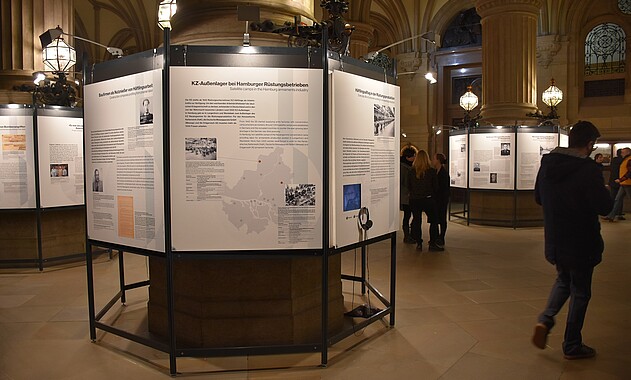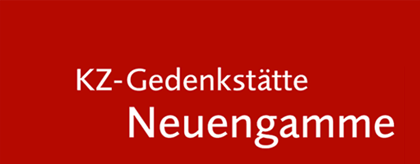
Travelling Exhibitions
The exhibitions below can be loaned from the Neuengamme Concentration Camp Memorial. Lenders are responsible for the transport and insurance costs. Our Research and Exhibitions Department designed each of these exhibitions to be shown in Hamburg City Hall originally on the Day of Remembrance of the Victims of National Socialism (International Holocaust Remembrance Day). Each exhibition consists of 48 information panels, each measuring 1.20 x 1 metres.
Between Coercion and Concentration Camp (2022)
Under the Nazi regime, thousands of socially marginalised persons living in poverty were persecuted as supposedly ‘anti-social’. But it was not until 2020 that the German Bundestag finally recognised them as victims of Nazi persecution. Who were these women and men, these adolescents and children? What had they suffered? Why did their history of persecution go unnoticed for decades?
The exhibition “Between Coercion and Concentration Camp. The Poor and the Marginalised in Hamburg during the Nazi Era” provides an account of the many hundreds of Hamburg residents who were written off, declared legally incompetent and forcibly sterilised, locked away in closed institutions and imprisoned in concentration camps. It sheds light on the role played by the public welfare services, welfare institutions and the police, and illustrates the tradition of exclusion and degradation of people deemed ‘anti-social’ – an attitude that persists to this day. (Curated by Frauke Steinhäuser with Alyn Beßmann and Lennart Onken)
All English panel texts from the exhibition can be seen here.
Survived! Now what? (2020)
In May 1945, the victims of Nazi persecution in forced labour camps, detention facilities and hiding places in Hamburg breathed a sigh of relief. The end of the war brought them the freedom they had longed for. Throughout northern Germany, British troops liberated hundreds of prisoners from the Neuengamme concentration camp and its satellite camps, all of which had recently been cleared. Many of the women, men and children from across Europe had only just survived the Nazi terror. Most of them were sick, emaciated and barely had any clothing. How were they supposed to get home? Did they even have a home and a family to go back to? For the survivors, returning to a ‘normal’ life was often a challenging process. And for many, being liberated did not mean an end to the misery. ( Curated by Alyn Beßmann and Lennart Onken )
All English panel texts from the exhibition can be seen here.
A City and its Concentration Camp (2019)
The City of Hamburg played a crucial part in the establishment of the Neuengamme concentration camp. After the heavy Allied air-raids in the summer of 1943, hundreds of concentration camp prisoners were forced to retrieve dead bodies and clear rubble in the city. Institutions and companies asked the SS to supply them with more and more prisoners for construction of temporary housing, production of building material and weapons as well as shipyard work. From 1944, 15 Neuengamme satellite camps emerged in the city. The inhabitants of Hamburg encountered concentration camp prisoners every day in the street, on their way to work and in companies.
The aim of this exhibition is to remind visitors of the use of prisoner labor in the city, its initiators and aftereffects. (Curated by Alyn Beßmann und Lisa Herbst)
All English panel texts from the exhibition can be seen here
Around the Alster. Hamburg History in National Socialism (2018)
The inner and outer Alster define the inner city of Hamburg. Canals separate different areas of the city. The offices, parks, villas, gardens, unspoiled shore lines, and traditional industrial sites describe the diverse live of the city and reflect the history of Hamburg. This exhibition examines these well-known locations to reveal the lesser-known aspects of Hamburg’s history under National Socialism.
In this exhibition, people appear in the foreground – those that lived in these spaces, worked in these sites, and enjoyed their free time outdoors. It is about uses of power, opportunism and protest, behavioural and political resistance, histories of architecture and industry, war economy and forced labour.
(Curated by Herbert Diercks and Lisa Herbst)
The Curiohaus Trials in Hamburg: Nazi War Crimes Tried in British Military Courts (2017)
From 1945 to 1949, the most important court for trying war crimes in the British Zone was housed in the Curiohaus in Hamburg. In total, 188 military trials against 504 defendants took place here. Who were these defendants? What crimes were they charged for? Who were their victims? And what role did the people they had persecuted play in these trials? These are the main questions explored in this exhibition.
(Curated by Alyn Beßmann and Dr. Reimer Möller)
All English panel texts from the exhibition can be seen here.
Hamburg Football under the Nazis: Insights into a History Romanticised for Decades (2016)
This exhibition documents the sport politics of the Nazi Party, the disciplinary actions taken against athletes as well as prohibitions and persecutions, with a main focus on football in Hamburg. The exhibition also highlights how sport was reorganised after the war, while the history of sport during the Nazi regime was not dealt with until much later.
(Curated by Herbert Diercks)
Flyer
Deported to Neuengamme Concentration Camp: Punitive Actions by the Wehrmacht and SS in Occupied Europe (2015)
During the Second World War the Wehrmacht, SS and police, as armed segments of the German occupying powers in the occupied nations of Europe, carried out "retaliatory measures" in many areas after alleged or actual attacks and other actions by the resistance. During such "punitive actions" in the summer of 1944, several hundred men were deported from Murat in France, Meensel-Kiezegem in Belgium and Putten in the Netherlands to the Neuengamme concentration camp. After the suppression of the Warsaw Uprising in summer of 1944, large numbers of Polish men and women were likewise sent to Neuengamme and other concentration camps. This exhibit depicts the events in these areas, and also shows how, 70 years after the end of World War II, these events are remembered in the affected villages and families, and in the Neuengamme Concentration Camp Memorial. (Curated by Katja Hertz-Eichenrode)
Flyer
“Euthanasia”: How the Nazis Murdered People with Disabilities and Mental Illnesses in Hamburg (2014)
This exhibition focuses on the men, women and children from Hamburg who were murdered by the Nazis as part of the “euthanasia" programme. It also addresses the involvement of Hamburg authorities, hospitals, physicians and nurses in the selection and murder of victims. (Curated by Herbert Diercks)
Flyer
“I Never Thought I Would Come Back.” The Lives of Former Forced Labourers and The Programme for Forced Labourers to Revisit Hamburg, 2001–2013. (2014)
This exhibition presents the programme in Hamburg for hosting former forced labourers and explores its significance for everyone involved. In learning about the lives of several forced labourers, we learn how the war years and being abducted to Hamburg have left memories that are still painfully alive today, even in old age.(Curated by: Katharina Hertz-Eichenrode)
Deserters and Other Victims of Persecution by the Nazi Military Judiciary: Wehrmacht Jurisdiction in Hamburg (2013)
This exhibition was inspired by a series of discussions regarding how to best commemorate those who were sentenced to death by the military judiciary, and also the deserters who were executed during World War II. The exhibition is the first of its kind to assemble in-depth information on the military courts in Hamburg with a focus on the stories of individual victims of the military court system. (Curated by Dr Magnus Koch, Lars Skowronski, Dr Detlef Garbe)
Documenting the Stadthaus. The Hamburg Police under the Nazis (2012)
The Hamburg Stadthaus was the headquarters of the Hamburg police, the criminal investigation department and the Gestapo until 1943. A memorial site for the Hamburg police during the Nazi period will be installed here in 2014 and 2015. This exhibition presents research done by Neuengamme Concentration Camp Memorial on the history of the Hamburg police between 1933 and 1945. (Curated by Herbert Diercks)
Flyer
Neuengamme Concentration Camp and the Site after the War in Focus. Pictures of the Camp and Memorial (2011)
The Neuengamme Concentration Camp Memorial relies on photographs that were taken by the camp SS as documentation of the camp’s history. However, it is important to also understand how these pictures were made, the way the SS staged the photographs, and how they function as documents. This is necessary in order to evaluate and contextualise these photographic sources. (Curated by Ute Wrocklage)
Flyer
“Freedom Lives!” Resistance and Persecution in Hamburg 1933–1945 (2010)
This exhibition provides an overview of the strength and range of resistance in Hamburg 1933–1945. Isolation, constant threat from the Gestapo and internal quarrels kept the resistance from achieving its essential goals. This exhibition is about the women and men who were persecuted because they fought against the Nazis. (Curated by Herbert Diercks)
“Places that Remain”: Memorials for the Victims of National Socialism in Hamburg (2009)
There are many memorials, large and small, that remember the crimes of the Nazis in Hamburg. The most well-known is the Neuengamme Concentration Camp Memorial, with its branches Bullenhuser Damm, Poppenbüttel Prefabricated Building and the Fuhlsbüttel Penal Facility. This exhibition provides information about Hamburg’s many memorial sites and their history. (Curated by Dr Detlef Garbe, Kerstin Klingel)
Flyer
The Hamburg Harbour under the Nazis. Economy, Slave Labour and Resistance (2008)
In 1989, the Neuengamme Concentration Camp Memorial began regularly offering “a different kind of harbour tour” to the sites of resistance and persecution around the Hamburg harbour. On these tours, we also discuss the “Führer buildings” which the Nazis planned to build along the waterfront. This exhibition brings this lesser known history of the harbour back to life with historic photos and documents. (Curated by Herbert Diercks)
“The Drawing Survives”: Pictures by Prisoners of Neuengamme Concentration Camp (2007)
Drawings by prisoners are an important historical source for the Neuengamme concentration camp. People made them either after the war or during imprisonment as a way of holding onto a sense of self in the concentration camp. Unlike the historical photographs taken by the SS, these drawings present us with the prisoners’ perspective. (Curated by Dr Maike Bruhns)
Flyer
Invisible Helpers: How Hiltgunt Zassenhaus from Hamburg and the Norwegian Seamen’s Mission Helped the Norwegians Imprisoned in Fuhlsbüttel 1940–1945 (2006)
Norwegian citizens were imprisoned either in the Fuhlsbüttel penal facility or in other prisons in northern Germany. They were thus far away from their home. Thanks to the Norwegian Seamen’s Mission, they were able to contact their families and receive assistance, especially food. Hiltgunt Zassenhaus from Hamburg, who was hired to translate and to keep them under surveillance, also did what she could to help, earning the reputation of a “prisoners’ angel”. (Curated by Herbert Diercks)
Flyer
“I Left My Youth in Hamburg”. Slave Labour in Hamburg 1940–1945 (2005)
During World War II, more than 400,000 slave labourers were imprisoned in more than 1,200 camps in Hamburg. For several years now, the Neuengamme Concentration Camp Memorial has worked to raise public awareness of their persecution while also encouraging former slave labourers to come and visit Hamburg. (Curated by Dr Jürgen Bönig, Katharina Hertz-Eichenrode and Dr Reimer Möller)
"That We Managed to Remain Women in this Terrible Struggle.” The History of the Women’s Satellite Camps of Neuengamme Concentration Camp (2004)
Few people in Hamburg know about the history of the women’s satellite camps of Neuengamme. The experiences of many of the female prisoners from all over Europe testify to how they, their families and their fellow countrywomen were persecuted. (Curated by Karin Heddinga, Ulrike Jensen)
“KolaFu”, a Place of Arbitrary Violence. The History of the Fuhlsbüttel Concentration Camp and Penal Facilities 1933–1945 (2003)
Prison institutions have existed in the Hamburg suburb of Fuhlsbüttel since the end of the 19th century. Between 1933 and 1945, they became important sites of Nazi persecution and were used as a concentration camp, a satellite camp of Neuengamme concentration camp and a house of correction in addition to their function as prisons. (Curated by Herbert Diercks)
